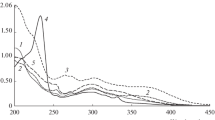Abstract
The effect of aqueous extract from yerba mate (Ilex paraguariensis) on Fe2+-induced lipid peroxidation in phospholipid liposomal membranes was investigated. The process of lipid peroxidation in liposomes was explored based on the kinetic curves of chemiluminescence reactions in the presence of coumarin C-525. With increasing concentration of aqueous extract from yerba mate in the liposome suspension, a rise in the time period within which the “slow flash” of chemiluminescence reached its maximum value and a decrease in its intensity were observed. This indicates a decrease in the oxidation rate of Fe2+ and a decrease in the rate of lipid radical formation, respectively. Similar results were obtained after addition of the classical radical inhibitors butylhydroxytoluene and trolox to liposomes. However, unlike radical inhibitors, a further increase in the concentration of aqueous extract from mate in the liposomal suspension (more than 2.5 μg of dry plant raw material/ml) was accompanied by a gradual decrease in the time period within which the slow flash of chemiluminescence reached its maximum value, which was typical of the action of iron chelating agents (EDTA and deferoxamine) and caused by a decreased time of Fe2+ oxidation to the critical concentration. It can be supposed that biologically active substances in the composition of aqueous extract from mate exhibit both radical scavenging activity and iron binding ability. The effects of some polyphenolic compounds from the composition of aqueous extracts from mate (quercetin, rutin, chlorogenic acid, and caffeic acid) on Fe2+‑induced liposome chemiluminescence were studied. It has been established that quercetin in a liposome-based model system acted as radical inhibitor. Our study showed that rutin, caffeic acid, and chlorogenic acid exhibit a mixed type of action, they can act as radical scavengers and iron-binding agents. Thus, inhibition of Fe2+-induced lipid peroxidation in biological membranes may be one of the mechanisms for the antioxidant effects of yerba mate observed in vivo.








Similar content being viewed by others
REFERENCES
A. Gawron-Gzella, J. Chanaj-Kaczmarek, and J. Cielecka-Piontek, Nutrients 13, 3706 (2021).
A. T. Valduga, I. L. Goncalves, E. Magri, and J. R. Delalibera Finzer, Food Res. Int. 120, 478 (2019).
S. Dudonne, X. Vitrac, P. Coutiere, et al., J. Agric. Food Chem. 57, 1768 (2009).
C. Anesini, S. Turner, L. Cogoi, and R. Filip, LWT – Food Sci. Technol. 45, 299 (2012).
Yu. O. Teselkin, I. V. Babenkova, L. A. Pavlova, et al., Biophysics 66, 125 (2021).
E. Rząsa-Duran, A. Kryczyk-Poprawa, D. Drabicki, et al., Antioxidants (Basel) 11, 371 (2022).
G. R. Schinella, G. Troiani, V. Davila, et al., Biochem. Biophys. Res. Commun. 269, 357 (2000).
M. Valko, D. Leibfritz, J. Moncol, et al., Int. J. Biochem. Cell Biol. 39, 44 (2007).
K. Jomova and M. Valko, Toxicology 283, 65 (2011).
H. Sies and D. P. Jones, Nat. Rev. Mol. Cell Biol. 21, 363 (2020).
Y. A. Hajam, R. Rani, and S. Y. Ganie, Cells 11, 552 (2022).
E. Gammella, S. Recalcati, and G. Cairo, Oxid. Med. Cell. Longevity 2016, 8629024 (2016).
E. Driomina, V. Sharov, and Yu. A. Vladimirov, Free Radic. Biol. Med. 15, 239 (1993).
Y. A. Vladimirov, E. V. Proskurnina, and D. Yu. Izmajlov, Biophysics 56, 1055 (2011).
S. Batzri and D. E. Korn, Biochim. Biophys. Acta 298, 1015 (1973).
Yu. A. Vladimirov and E. V. Proskurnina, Biochemistry (Moscow) 74, 1545 (2009).
K. A. Berte, M. R. Beux, P. K. Spada, et al., J. Agric. Food Chem. 59, 523 (2011).
M. Bojić, V. Simon Haas, D. Sarić, and Z. Maleš, J. Anal. Methods Chem. 2013, 658596 (2013).
G. Jones, S. K. Goswami, H. Kang, et al., Nanomedicine 15, 1341 (2020).
D. Bellotti and M. Remelli, Molecules 26, 3255 (2021).
D. Yu. Yegorov, A. V. Kozlov, O. A. Azizova, and Yu. A. Vladimirov, Free Radic. Biol. Med. 15, 565 (1993).
Z. Cheng and Y. Li, Chem. Rev. 107, 748 (2007).
L. A. Romodin, Acta Nat. 13, 90 (2021).
A. O. Ademosun, G. Oboh, F. Bello, and P. O. Ayeni, J. Evidence-Based Complementary Altern. Med. 21, NP 11 (2016).
Y. Kono, S. Kashine, T. Yoneyama, et al., Biosci. Biotechnol. Biochem. 62, 22 (1998).
T. C. Genaro-Mattos, A. Q. Mauricio, D. Rettori, et al., PloS One 10, e0142402 (2015).
F. Martins, A. J. Suzan, S. M. Cerutti, et al., Br. J. Nutr. 101, 527 (2009).
L. Bravo, R. Mateos, B. Sarria, et al., Fitoterapia 92, 219 (2014).
A. C. Colpo, M. E. de Lima, M. Maya-Lopez, et al., Appl. Physiol. Nutr. Metab. 42, 1172 (2017).
L. F. Gonzalez Arbelaez, J. C. Fantinelli, A. Ciocci Pardo, et al., Food Funct. 7, 816 (2016).
R. L. Matsumoto, D. H. Bastos, S. Mendonca, et al., J. Agric. Food Chem. 57, 1775 (2009).
A. M. Becker, H. P. Cunha, A. C. Lindenberg, et al., Plant Foods Hum. Nutr. 74, 495 (2019).
Author information
Authors and Affiliations
Corresponding author
Ethics declarations
Conflict of interests. The authors declare that they have no conflicts of interest.
Statement of the welfare of animals. This article does not contain any studies involving animals or human participants performed by any of the authors.
Additional information
Translated by D. Timchenko
Abbreviations: BAS, biologically active substance; LP, lipid peroxidation; BHT, butylhydroxytoluene (2,6-di-tert-butyl-4-methylphenol).
Rights and permissions
About this article
Cite this article
Teselkin, Y.O., Babenkova, I.V., Kochetova, A.A. et al. Inhibitory Effect of Aqueous Extract from Yerba Mate (Ilex paraguariensis) on the Process of Lipid Peroxidation of Liposomal Membranes. BIOPHYSICS 67, 541–548 (2022). https://doi.org/10.1134/S0006350922040194
Received:
Revised:
Accepted:
Published:
Issue Date:
DOI: https://doi.org/10.1134/S0006350922040194




